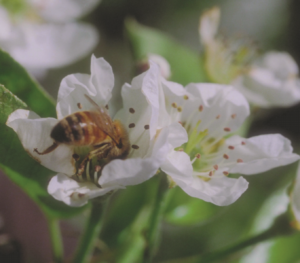 With the winter winds a-howlin’ outside, it’s hard to think about the beautiful blooms lying in your garden. But there’s still someone out there thinking about those blooms — honeybees! Honeybees are busy collecting nectar from early spring all the way through late fall, depending on where you live. This nectar is what gives bees, butterflies, and other insects the energy they need to survive the winter.
With the winter winds a-howlin’ outside, it’s hard to think about the beautiful blooms lying in your garden. But there’s still someone out there thinking about those blooms — honeybees! Honeybees are busy collecting nectar from early spring all the way through late fall, depending on where you live. This nectar is what gives bees, butterflies, and other insects the energy they need to survive the winter.
Here are some flowers you can plant that’ll bloom through the mid-to-late fall to give these guys a little boost before they hibernate:
Coneflowers. These early-summer to early-fall bloomers are beautiful additions to your backyard garden — and they come in a variety of colors: pink, white, red, and yellow. Coneflowers prefer lots of sun and warm weather, and they won’t mind it if you forget to water them for a day or two. These daisy cousins are drought-resistant and might attract butterflies and hummingbirds along with honeybees.
Dianthus. Blooming in early summer to early fall, dianthus flowers come in all shapes and sizes, from miniature plants under 6 inches up to the giant varieties that can reach up to 3 feet in height. Like cornflowers, these pretty perennials prefer more sun than shade, and deadheading the flowers will encourage more blooms before winter. The most common kind of dianthus is the carnation, however, they can come in a wide variety of colors: yellow, red, pink, purple, and some varieties even have striping along the inner or outer edges of the petals.
Black-Eyed Susan. When these flowers start their blooming, it’s a sure sign fall is around the corner. Black-eyed Susans typically bloom when most other flowers have finished for the season, from midsummer to early fall. You can buy annual and perennials versions of these flowers, but the perennial variety will save you some trouble. Black-eyed Susans like full sun, are drought-tolerant, and will provide shocks of bright yellow all over your yard.
New York aster. New York asters, or purple asters as they are also called, bloom in the late summer to early fall, and are fantastic sources of nectar for bees, butterflies, and hummingbirds. These daisy-like flowers are sun lovers, deer and rabbit resistant, and frost resistant beauties that will keep your yard beautifully decorated the chilly fall months.
Russian Sage. These tall, blue flowers are midsummer to mid-fall bloomers and are good for privacy protection, if you have a nosy neighbor next door. Russian sages usually grow to be between 3 and 8 feet tall, providing a beautiful natural fence line if planted around the outer edge of your yard. Like the other flowers listed here, Russian sages like full sun and are drought tolerant, making them ideal plants for a busy person.
Plant any one — or all — of these in your backyard to help your buzzing buddies gather enough food to survive through the winter. Come spring, the queen bee will thank you from her new hive!
Discover more from Jerry Baker's Whats Growin' On
Subscribe to get the latest posts sent to your email.
